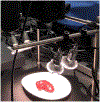LED-based Hyperspectral Endoscopic Imaging
- PMID: 36794092
- PMCID: PMC9928531
- DOI: 10.1117/12.2609023
LED-based Hyperspectral Endoscopic Imaging
Abstract
Hyperspectral endoscopy can offer multiple advantages as compared to conventional endoscopy. Our goal is to design and develop a real-time hyperspectral endoscopic imaging system for the diagnosis of gastrointestinal (GI) tract cancers using a micro-LED array as an in-situ illumination source. The wavelengths of the system range from ultraviolet to visible and near infrared. To evaluate the use of the LED array for hyperspectral imaging, we designed a prototype system and conducted ex vivo experiments using normal and cancerous tissues of mice, chicken, and sheep. We compared the results of our LED-based approach with our reference hyperspectral camera system. The results confirm the similarity between the LED-based hyperspectral imaging system and the reference HSI camera. Our LED-based hyperspectral imaging system can be used not only as an endoscope but also as a laparoscopic or handheld devices for cancer detection and surgery.
Keywords: FPGA; Hyperspectral imaging; cancer; endoscopy; handheld device; laparoscope; micro-LED; surgery.
Figures













References
-
- Siegel RL, Miller KD, Fuchs HE, and Jemal A, “Cancer statistics, 2021,” CA: a cancer journal for clinicians, 71(1), 7–33 (2021). - PubMed
-
- Chadwick G, Groene O, Riley S, Hardwick R, Crosby T, Hoare J, Hanna GB, Greenaway K, and Cromwell DA, “Gastric cancers missed during endoscopy in England,” Clinical gastroenterology and hepatology, 13(7), 1264–1270. e1 (2015). - PubMed
Grants and funding
LinkOut - more resources
Full Text Sources
